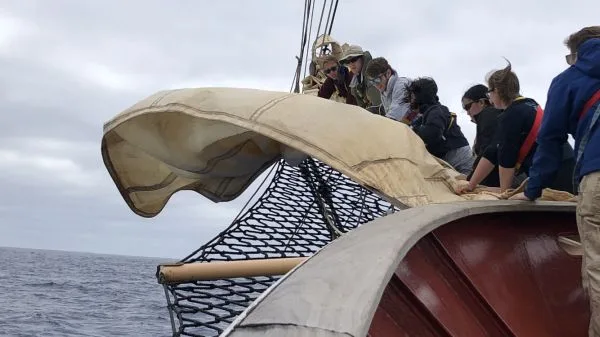News
First Sunset in the Gyre!

Author: Nathan Miller, B Watch, Franklin and Marshall College
Ship’s Log
Position
29° 24.3’N 128° 10.4’W
Heading
280° per ship’s compass
Speed
7 knots
Sail Plan
Four lowers and jib tops’l
Weather
Partly cloudy, with clouds clearing
Wind
Beaufort Force 4, NNE
Description of location
Edge of the North Pacific Subtropical Gyre, 1200 nm off the California Coast
Today marks 10 days underway on the Seamans, and we’ve already come a long way, emotionally and physically. We’ve gone through a few watch rotations now, and we’re starting to get the hang of it—report to the quarterdeck 10 minutes before watch turnover, stand watch for 6 hours, be as helpful as possible, and sleep right after watch. After relying on engine power for our first few days, we’re happy to be sailing on wind power alone for almost a week now, raising one of the upper sails to harness the stronger winds several meters above the deck if we want more speed.
 Sunset
Sunset
This afternoon, after Cap’n Rick gave us an illustrated lesson on sail theory, we deployed another buoy for the National Weather Service. Deploying these has been an interesting experience. We follow the instructions laid out for us, which entail carrying the buoy in its box to the stern of the ship, recording our exact time and GPS position, and chucking it over the side—cardboard box and all. It’s a low-tech method of deploying a high-tech device that will fill in data gaps pertaining to weather observation and prediction in the North Pacific, to the benefit of sailors and mariners like us.
Personally, I was lucky enough to clip in with my harness and venture out on the headrig twice today—once to undo the knots holding down the jib tops’l (more speed!) and once to help furl the jib so Darcy and Süpi, the mate and scientist for B-watch, could untangle the jib sheet. Being out on the headrig is a surreal experience. The pitching and rolling of the ship as she bobs over swells feels accentuated when standing on a bouncy surface beyond the hull of the ship, which makes it even more thrilling to look down under my feet and see the blue Pacific Ocean splashing and spraying as our bow crashes through the waves fifteen feet below me. It’s funny how different places on the ship lend different perspectives of scale to the Seamans. The ship feels pretty big and formidable when I climb down into the engine room to take readings on our systems, but on the headrig I might as well be an ant clinging to a cork in a planet-sized bathtub—tossed around at the mercy of wave motion and buoyancy, holding on with my feet and knees (and always clipped in with my harness) so I can work with my hands.
Today ended with a warm breeze and a beautiful sunset, a welcome break from the gray dawns and dusks we’ve been seeing so far. For me, the weather change came with an emotional change: I finally feel like I’m getting the hang of being on a ship. I find the pitching and rolling to be comforting now, and I’m feeling the excitement of sailing under wind power alone, and the confidence I need to conquer the steep learning curve. Some of our sailing knowledge will be tested tomorrow when we have a relay race to test our knowledge of the ship’s rigging—the watch that can locate lines the fastest wins!
– Nathan Miller, Franklin and Marshall College/B-Watch
Contact: Douglas Karlson, Director of Communications, 508-444-1918 | dkarlson@sea.edu